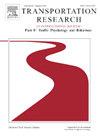Examining psychological factors associated with pedestrians’ technology use while walking and risky street-crossing behavior: Incorporating heterogeneity effect
IF 3.5
2区 工程技术
Q1 PSYCHOLOGY, APPLIED
Transportation Research Part F-Traffic Psychology and Behaviour
Pub Date : 2025-02-01
DOI:10.1016/j.trf.2025.01.003
引用次数: 0
Abstract
The widespread integration of technology into everyday life has made pedestrians increasingly susceptible to engaging with distractions. Consequently, it is important to understand the factors that drive their use of technology while walking and the associated risky street-crossing behaviors. Given that smartphone and smartwatch use are among the most common technology-related activities in pedestrian behavior, this study aimed to investigate the influence of behavioral and psychological factors, including fear of missing out (FoMO), mindfulness, nomophobia, self-identity, and self-control on pedestrian technology use while walking (i.e., smartphone and smartwatch use) and their propensity for risky street-crossing behavior. Data were collected from an online survey of 2221 participants in different cities of Iran. A structural equation model (SEM) was developed to explore these relationships, drawing on insights from previous theoretical frameworks. To account for the effect of heterogeneity, the relationship between constructs was explored among different individual groups using Multiple Indicator Multiple Causes (MIMIC) models and Multi-Group Analysis (MGA). The results revealed that mindfulness, followed by nomophobia and self-identity, were the strongest predictors of technology use while walking. Technology use while walking was more frequent among males, individuals aged between 18 and 24, those with prior crash experience and in the trips after 4 pm. In addition, individual characteristics proved to pose a moderating effect on pedestrian technology use and its predictors. FoMO emerged to be a more significant predictor of males’ personality factors and their risky behaviour, while nomophobia, mindfulness, and self-identity were stronger predictors of females’ personality factors, technology use, and risky behaviour. The findings of this study contribute to increasing knowledge in the field of pedestrian safety and inform the development of targeted interventions aimed at mitigating risky behaviours and promoting safer urban environments.
求助全文
约1分钟内获得全文
求助全文
来源期刊
CiteScore
7.60
自引率
14.60%
发文量
239
审稿时长
71 days
期刊介绍:
Transportation Research Part F: Traffic Psychology and Behaviour focuses on the behavioural and psychological aspects of traffic and transport. The aim of the journal is to enhance theory development, improve the quality of empirical studies and to stimulate the application of research findings in practice. TRF provides a focus and a means of communication for the considerable amount of research activities that are now being carried out in this field. The journal provides a forum for transportation researchers, psychologists, ergonomists, engineers and policy-makers with an interest in traffic and transport psychology.

 求助内容:
求助内容: 应助结果提醒方式:
应助结果提醒方式:


